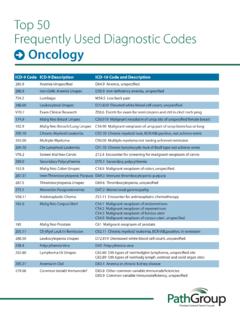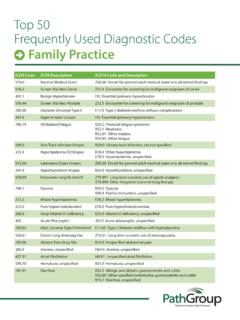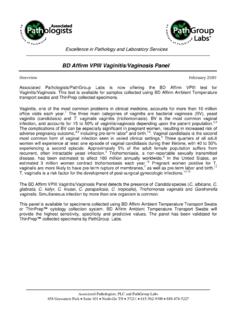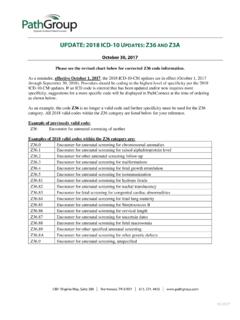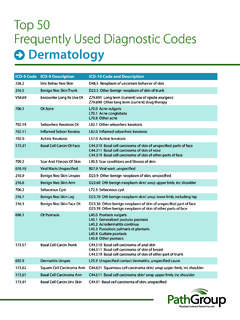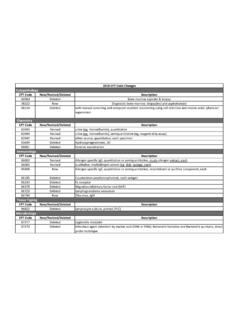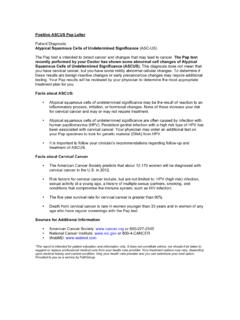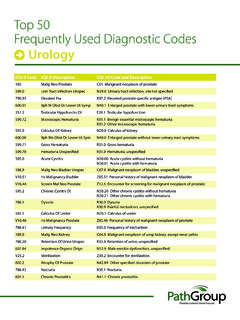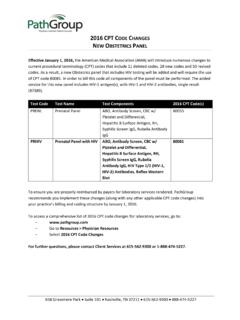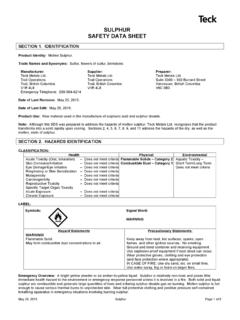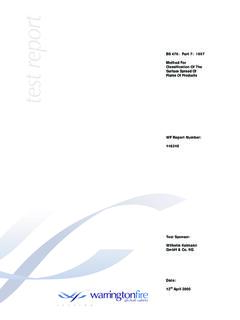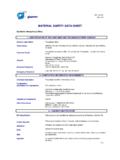Transcription of Safety Data Sheet - Pathgroup
1 SECTION 1: Identification of the substance/preparation and of the Company/undertakingProduct Identifier Product NameThinPrep CytoLyt SolutionSafety data Sheet number85092-001 Recommended use of the chemical and restrictions on use Specific use(s)A methanol based, buffered preservative solution used to support cells during transportRecommended UseIn vitro diagnosticDetails of the supplier of the Safety data Sheet ManufacturerHologic Campus DriveMarlborough, MA 01752 United States1-508-263-290024 Hour Emergency Phone NumberChemtrec, and Canada 1-800-424-9300; Chemtrec International + 1-703-741-5970 For further information, please contact: 2: Hazards identificationClassification This chemical is considered hazardous by the 2012 OSHA Hazard Communication Standard (29 CFR ).Acute toxicity - OralCategory 4 Acute toxicity - DermalCategory 4 Acute toxicity - Inhalation (Vapors)Category 4 Specific target organ toxicity (single exposure)Category 1 Emergency Overview Label Elements Signal wordDangerPage 1/9 Physical hazardsFlammable liquids Category 3 Globally Harmonized System (GHS) ( United States of America , Canada and Mexico )ThinPrep CytoLyt SolutionSafety data SheetHazard StatementsH302 - Harmful if swallowedH312 - Harmful in contact with skinH332 - Harmful if inhaledH370 - Causes damage to organsH226 - Flammable liquid and vaporPrecautionary Statements - PreventionP210 - Keep away from heat/sparks/open flames/hot surfaces.
2 No smokingP280 - Wear protective gloves/protective clothing/eye protection/face protectionP260 - Do not breathe dust/fume/gas/mist/vapors/sprayP264 - Wash face, hands and any exposed skin thoroughly after handlingP270 - Do not eat, drink or smoke when using this productP233 - Keep container tightly closedPrecautionary Statements - ResponseP307 + P311 - IF exposed: Call a POISON CENTER or doctor/physicianP305 + P351 + P338 - IF IN EYES: Rinse cautiously with water for several minutes. Remove contact lenses, if present and easy todo. Continue rinsingP303 + P361 + P353 - IF ON SKIN (or hair): Remove/Take off immediately all contaminated clothing. Rinse skin with water/showerP363 - Wash contaminated clothing before reuseP304 + P340 - IF INHALED: Remove victim to fresh air and keep at rest in a position comfortable for breathingCall a POISON CENTER or doctor/physician if you feel unwellP301 + P312 - IF SWALLOWED: Call a POISON CENTER or doctor/physician if you feel unwellP330 - Rinse mouthFireIn case of fire: Use CO2, dry chemical, or foam for Statements - StorageP405 - Store locked upP403 + P235 - Store in a well-ventilated place.
3 Keep coolPrecautionary Statements - DisposalP501 - Dispose of contents/container in accordance with local/regional/national/international not otherwise classified (HNOC) Other Information of the mixture consists of ingredient(s) of unknown toxicitySECTION 3: Composition/information on ingredientsSubstances Not ApplicableMixtures MixturesOSHA Hazard ClassificationThis material is considered hazardous by the OSHA Hazard Communication Standard (29 CFR ).Component nameCAS No%Methanol67-56-114 - 25 SECTION 4: First aid measuresFirst aid measuresPage 2/9 ThinPrep CytoLyt SolutionGeneral adviceImmediate medical attention is required. In case of accident or unwellness, seek medicaladvice immediately (show directions for use or Safety data Sheet if possible).Eye contactImmediately flush with plenty of water. After initial flushing, remove any contact lenses andcontinue flushing for at least 15 minutes. Keep eye wide open while rinsing. Call a ContactWash off immediately with plenty of medical attention is required.
4 Remove to fresh air. If not breathing, give artificialrespiration. Avoid direct contact with skin. Use barrier to give mouth-to-mouth NOT induce vomiting. Call a physician or poison control center immediately. Never giveanything by mouth to an unconscious person. Drink plenty of of the first aiderRemove all sources of of any immediate medical attention and special treatment neededNote to physiciansTreat 5: Firefighting measuresFlammabilityFlammable liquid and Extinguishing MediaDry chemical, CO2, water spray or alcohol-resistant foam. Water spray, fog oralcohol-resistant foam. Move containers from fire area if you can do it without risk. Dike firecontrol water for later disposal; do not scatter the material. Use water spray or fog; do notuse straight Extinguishing MediaCAUTION: All these products have a very low flash point. Use of water spray when fightingfire may be inefficientSpecific hazards arising from thechemicalVapors may form explosive mixtures with air.
5 Vapors may travel to source of ignition andflash back. Most vapors are heavier than air. They will spread along ground and collect inlow or confined areas (sewers, basements, tanks). Vapor explosion hazard indoors,outdoors or in sewers. Those substances designated with a "P" may polymerize explosivelywhen heated or involved in a fire. Runoff to sewer may create fire or explosion equipment andprecautions for firefightersAs in any fire, wear self-contained breathing apparatus pressure-demand, MSHA/NIOSH(approved or equivalent) and full protective 6: Accidental release measuresPersonal precautions, protective equipment and emergency procedures Personal precautionsRemove all sources of ignition. Evacuate personnel to safe areas. Ensure adequateventilation, especially in confined areas. Use personal protective equipment as precautions Prevent further leakage or spillage if safe to do so. Prevent product from entering drains. Donot flush into surface water or sanitary sewer and material for containment and cleaning up Methods for containmentPrevent further leakage or spillage if safe to do so.
6 Cover powder spill with plastic Sheet ortarp to minimize spreading. Dike far ahead of liquid spill for later for cleaning upDam up. Soak up with inert absorbent material ( sand, silica gel, acid binder, universalbinder, sawdust). Pick up and transfer to properly labeled containers. Soak up with inertabsorbent 3/9 ThinPrep CytoLyt SolutionSECTION 7: Handling and storagePrecautions for safe handlingKeep away from heat, sparks, flame and other sources of ignition ( , pilot lights, electricmotors and static electricity). Keep container tightly closed. Ensure adequate ventilation,especially in confined on safe handlingEnsure adequate ventilation, especially in confined areas. Keep away from heat, sparks,flame and other sources of ignition ( , pilot lights, electric motors and static electricity).Take precautionary measures against static discharges. Use spark-proof tools andexplosion-proof equipment. All equipment used when handling the product must for safe storage, including any incompatibilitiesStorageStore in accordance with local regulations.
7 Use appropriate containment to avoidenvironmental ConditionsKeep tightly closed in a dry and cool place. Keep in properly labeled containers. Keep awayfrom heat, sparks, flame and other sources of ignition ( , pilot lights, electric motors andstatic electricity).Incompatible oxidizing agents. Acids. 8: Exposure Controls/Personal States of America Component nameACGIH TLVOSHA PELNIOSH IDLHM ethanol 67-56-1 STEL: 250 ppmTWA: 200 ppmS*TWA: 200 ppmTWA: 260 mg/m3(vacated) TWA: 200 ppm(vacated) TWA: 260 mg/m3(vacated) STEL: 250 ppm(vacated) STEL: 325 mg/m3(vacated) S*IDLH: 6000 ppmTWA: 200 ppmTWA: 260 mg/m3 STEL: 250 ppmSTEL: 325 mg/m3 Canada Component nameBritish Columbia OELQ uebec OELO ntario TWAM ethanol 67-56-1 TWA: 200 ppmSTEL: 250 ppmSkinTWA: 200 ppmTWA: 262 mg/m3 STEL: 250 ppmSTEL: 328 mg/m3 SkinTWA: 200 ppmSTEL: 250 ppmSkinMexico ComponentCarcinogenicityExposure LimitsMethanol 67-56-1 ( 14 - 25 )-Mexico: TWA 200 ppmMexico: TWA 260 mg/m3 Mexico: STEL 250 ppmMexico: STEL 310 mg/m3 NIOSH IDLH Immediately Dangerous to Life or HealthOther InformationVacated limits revoked by the Court of Appeals decision in AFL-CIO v.
8 OSHA, 965 962(11th Cir., 1992).Appropriate engineering controlsEngineering ControlsProvide adequate ventilation. Showers. Eyewash protection measures, such as personal protective equipment Eye/face protectionTight sealing Safety 4/9 ThinPrep CytoLyt SolutionSkin and body protectionWear suitable protective ProtectionWear protective gloves. Gloves made of plastic or protectionNot ApplicableGeneral Hygiene ConsiderationsRegular cleaning of equipment, work area and clothing is recommended. When using donot eat, drink or Information Environmental exposure controlsNo information 9: Physical and chemical propertiesInformation on basic physical and chemical properties Physical stateLiquidAppearanceColorless, LiquidColorColorlessOdorAlcohol-likeOdor thresholdNo information availableProperty Values pH7 Melting point/freezing pointBoiling point / boiling range80 C / 177 FFlash point41 C / 105 FMethodCC (closed cup)Evaporation rate> 1 Flammability (solid, gas)No information availableFlammability Limits in AirUpper flammability limits36%Lower flammability pressure127 mmHgVapor (Air=1)Relative densitySpecific solubilityMiscibleSolubility(ies)No information availablePartition coefficientNo information availableAutoignition temperature385 C / 725 FDecomposition temperatureNo information availableViscosityNo information availableExplosive propertiesNo information availableOxidizing propertiesNo information availablePercent Volatile>99%SECTION 10.
9 Stability and reactivityReactivityNone under normal use under normal of Hazardous ReactionsNone under normal use polymerizationNone under normal use to avoidHeat, flames and oxidizing agents. Acids. Decomposition ProductsNone under normal use to avoidStrong oxidizing agents. Acids. 11: Toxicological informationPage 5/9 ThinPrep CytoLyt SolutionInformation on likely routes of exposure Product InformationMay be harmful by inhalation, ingestion, or skin under normal use contactNone under normal use ContactNone under normal use under normal use on toxicological effects Delayed and immediate effects as well as chronic effects from short and long-term exposure Skin corrosion/irritationNo information eye damage/eye irritationNo information cause skin and eye information cell mutagenicityNo information information toxicityNo information - single exposureNo information - repeated exposureNo information Organ EffectsCentral nervous system, Eyes, Gastrointestinal tract (GI), Respiratory system, hazardNo information measures of toxicity - Product Information Unknown Acute of the mixture consists of ingredient(s)
10 Of unknown toxicityThe following values are calculated based on chapter of the GHS document .SECTION 12: Ecological informationEcotoxicity 20 - 50% of the mixture consists of components(s) of unknown hazards to the aquatic nameAlgae/aquatic plantsFishToxicity tomicroorganismsCrustaceaSodium Chloride 7647-14-512946: 96 h Lepomismacrochirus mg/L LC50static1000: 48 h Daphnia magnamg/L EC50 - : 48h Daphnia magna mg/LEC50 StaticPotassium Chloride 7447-40-72500: 72 h Desmodesmussubspicatus mg/L EC501060: 96 h Lepomismacrochirus mg/L LC50static825: 48 h Daphnia magnamg/L EC50 83: 48 hDaphnia magna mg/L EC50 StaticPersistence and degradabilityNo information information information namePartition coefficientMethanol adverse effectsNo information 13: Disposal 6/9 ThinPrep CytoLyt SolutionWaste treatment methodsDisposal of wastesDisposal should be in accordance with applicable regional, national and local laws from Residues / UnusedProductsDisposal should be in accordance with applicable regional, national and local laws packagingDisposal should be in accordance with applicable regional, national and local laws EPA Waste NumberU154 D001 Component nameRCRARCRA - Basis for ListingRCRA - D Series WastesRCRA - U Series WastesMethanol 67-56-1 Included in waste stream:F039U154 This product contains one or more substances that are listed with the State of California as a hazardous nameCalifornia Hazardous Waste StatusMethanol 67-56-1 ToxicIgnitableSECTION 14: Transport informationDOT UN/ID NoUN1993 Proper shipping nameFlammable liquid, (Methanol)Hazard Class3 Packing GroupIIIR eportable Quantity (RQ)Methanol.
